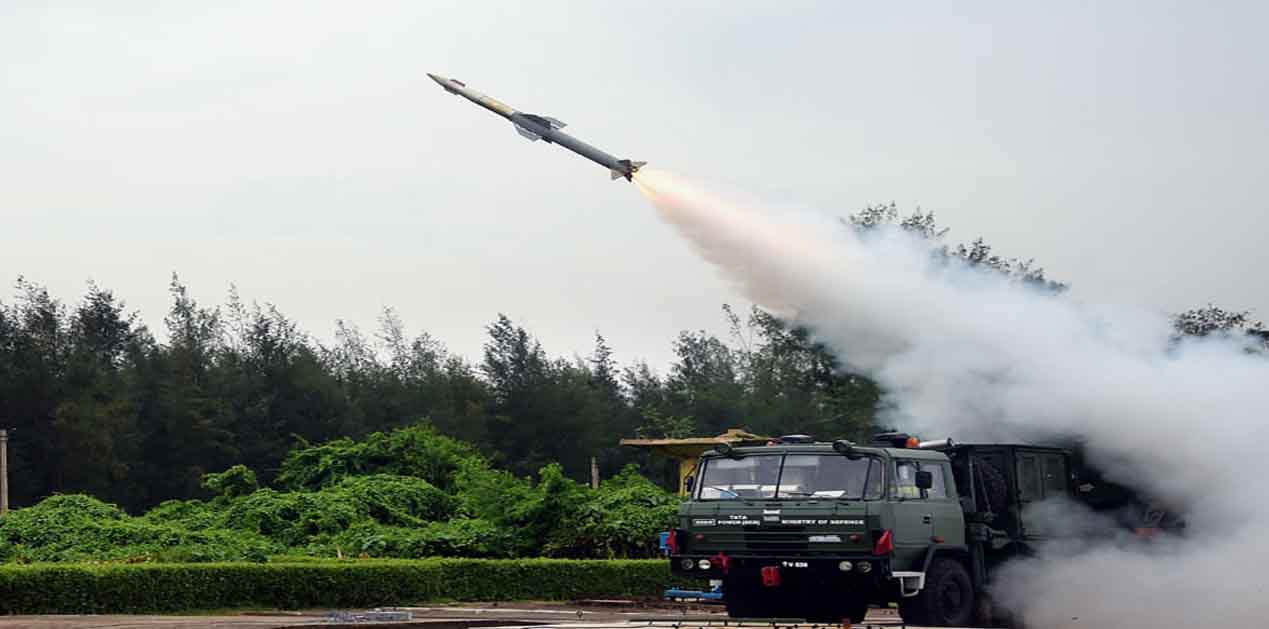Whenever we move closer to acquiring an indigenous capability, we actually move a notch up in our swabhiman (self-esteem), in our national pride and in our celebration of "Make in India". One such event took place recently, when the Defence Research and Development Organisation (DRDO) carried out the test firing of its ingeniously developed Quick Reaction Surface to Air Missile or QRSAM (I). This article puts this launch event into the perspective and brings out the associated imperatives which need to be addressed alongside these developments.
The Event
QRSAM (I), which is yet to get a formal name is a Surface to Air Missile (SAM) designed and developed by DRDO with Bharat Electronics Ltd (BEL) as the Production Agency. This missile was flight tested at the Integrated Test Range (ITR), Balasore, Odisha, at 12:05 PM on 30 May, 2018. It was the first test of the booster phase of the missile. Booster phase is that phase where the propellant unit lifts the missile from its launching pad and provides it with the thrust and acceleration to fly to its intended target. 1
The booster itself belonged to the latest technology. It is called Solid Fuel Ducted Ramjet (SFDR). This technology has been jointly developed by India and Russia and marks India's entry into a select club of nations that use next generation missile technology against manoeuvring targets. SFDR technology boosts the performance of the missile by enhancing its strike range and improving its kill effectiveness thereby compromising the effectiveness of conventional threat missiles.

In this test, the nozzle-less SFDR booster propelled the missile to its designed speed of 3 Mach, thus making this missile the fastest QRSAM in the world in its class. Accelerating the missile to such a tremendous speed in the boost phase itself, is to ensure that the missiles will have adequate residual energy to take on manoeuvring targets even in the end game (terminal phase) when its seeker will be locked on with the target to be destroyed. Enhanced end-game manoeuvrability is likely to make the missile highly lethal.
In the next flight test, the other components of the missile like the high technology seeker equipment and more, are likely to be tested. This missile is under development since 2013. A part of the knowhow and experience also belongs to the DRDO's association with the French for the joint development of Maitri Missile.2,3
Putting QRSAM (I) in the Perspective
The requirement for the Ground Based Air Defence Weapons (GBADWS), deployed in a layered-and-tiered-defence mechanism as a part of the Integrated Air Defence System (IADS), is to inflict successive and continuous punishment to the incoming threat vehicles from the time a target enters the kill zone of the longest range weapon till the time it continues to draw inward to its intended target and releases its lethal load/or abandons its mission.
For the above, an integrated family of GBADWS is required, which besides the guns (towed and self-propelled) for the terminal end engagement, has a hierarchy of SAMs. These SAMs basically comprise of VSHORADS (man portable, shoulder/pedestal fired very short range missiles), which combine with guns to provide the gun-missile mix deployment with a coverage up to 6-10 kms, Short Range SAMs (SRSAMs) providing air defence missile cover up to 20-30 km, Medium Range SAMs (MRSAMs) with an operational range of 70-100 Kms and Long Range SAMs (LRSAMs) with ranges in excess of 100 kms. The concept is to effectively cover with fire, the entire range and altitude bracket from long ranges to the terminal end.
QRSAMs also belong to the above integrated family, though their mention normally does not appear in the above listing of GBADWS. The reason for this is the fact, that QRSAMs are only one of the types of SRSAMs with some distinctive signature features. In that, while the above listing of SAMs is essentially driven by the range and altitude bracket of their kill zones, QRSAMs are defined by their characteristic operational capabilities.
Such missiles are high mobility and high maneuverability weapon systems that are required to provide mobile air defence cover to the mechanised assets of the field force. Due to this nature of task, QRSAMs must meet the following three criteria:-
1. Ability to keep pace with the mechanised columns in time and space.
2. Ability to carry out surveillance and tracking while on the move.
3. Capability to deliver effective fire immediately on halt.
It is now possible to check out the reported combat virtues of the recently tested QRSAM (I) with respect to the above operational requirements. 4
The weapon system is configured on High Mobility Vehicles (HMVs) and is capable of mobility in cross country terrains like plains, semi desserts and desserts. It therefore will be able to keep pace with mobile and mechanised assets in the field force in time and space. The integrated system is capable of surveillance, target acquisition and tracking while on the move and firing on short halts. It's reported kill zone is 3 km to 30 km in range, 30 m to 6 km in altitude and 360 degrees in azimuth. The weapon system has an all-weather operational capability. This meets the balance operational requirements of QRSAMs set above. For realising the above capabilities, it is reported that the system has surveillance radar (range 120 km) and fire control radar (target tracking up to 80 km). For terminal engagement independent of the ground radars, the missile uses a radio frequency (RF) seeker.
The typical threat to mobile and mechanised columns of the field force is essentially from state-of-the-art attack helicopters doing ground-hugging or Nap of the Earth (NOE) flying, and (or) from low flying highly manoeuvrable, highly lethal aircrafts and missiles. The SADR driven QRSAM (I) with enhanced mobility and maneuverability is likely to prove effective against such a threat.
Some of the typical QRSAMs in the world are Pantsyr (Russia), Spyder (M/s IAI Israel) and QRSAM (M/s Rafael Israel). Open sources report of the ‘Buy Global case for QRSAMs being processed in the past,5 and how the DRDO has come over time to meet the challenge6.
The author is of the view that if the indigenous capability has come about, it should be the choice of a "swabhimani vayu rakshak" (proud air defender) provided such a capability passes the following litmus test:-
1. The reported operational capabilities of the weapon are actually realised and are proven during user trials (likely sometimes in 2019).
2. The system is realised in a fast time frame, so that the critical operational voids are not left hanging indefinitely. This time frame must be faster than what could be the expected lead time in procuring the QRSAMs ex-import.
3. The associated command, control and battle management infrastructure, as well as the logistic and administrative tail is realised on parallel paths as the main frame weapon develops.
4. Once cleared for production, the quantum throughput year-on-year should be such that it does not starve the users by ‘too little and too late’. This is a very tall order and will call for setting parallel facilities, increasing the prospective sub-vendor base, involving the private industry to partake in the production processes, outsourcing on public-private-partnership (PPP) model and more.
Only when the above stated litmus test is passed, the 'sense' of swabhiman will become a 'reality' to be proud about.
References:
1. https://www.newsindianexpress.com>india-achieves major milestone-with -successful-test-of-surface-to-air-missile-the new-indian-express. (Accessed on 01 June, 2018).
2. https://www.economictimes.indiatimes.com>missile-technology-india-successfully-test-fires-SFDR-propulsion-based-missile. (Accessed on 01 June, 2018).
3. https://www.sputnicnews.com>maiden-test-of-india's-next -gen- SFDR-sam. (Accessed on 02 June, 2018).
4. https://www.livefistdefence.com>exclusive-what-india's-new-qrsam-looks-like. (Accessed on 02 June, 2018).
5. https://www.timesofindia.indiatimes.com>armypursuing-procurement-of-foreign-made-rqsam;parrikar. (Accessed on 02 June, 2018).
6. https://www.pressreader.com>india>mail-today-2018-03-16-drdo-ready-for-army's-missile-challange. (Accessed on 02 June, 2018).
(The paper does not necessarily represent the organisational stance. The author certifies that the article/paper is original in content, unpublished and it has not been submitted for publication/web upload elsewhere, and that the facts and figures quoted are duly referenced, as needed, and are believed to be correct).
(The paper does not necessarily represent the organisational stance... More >>
Image Source: http://pib.nic.in/newsite/photoright.aspx?phid=110572










Post new comment